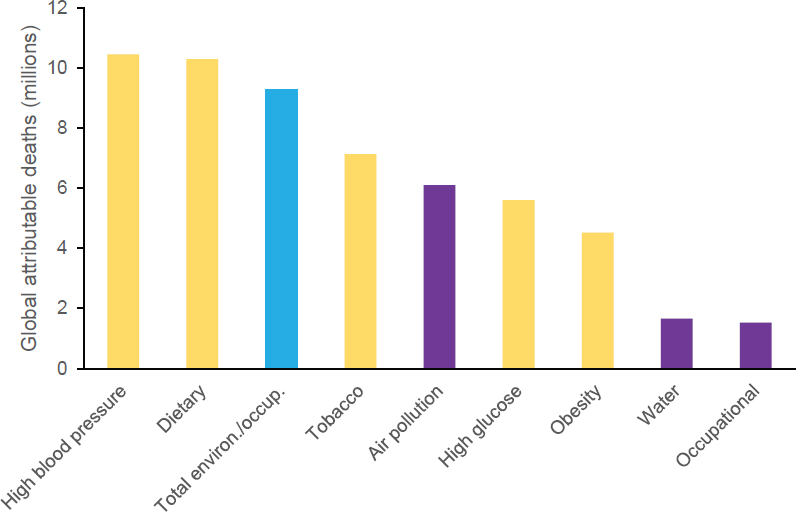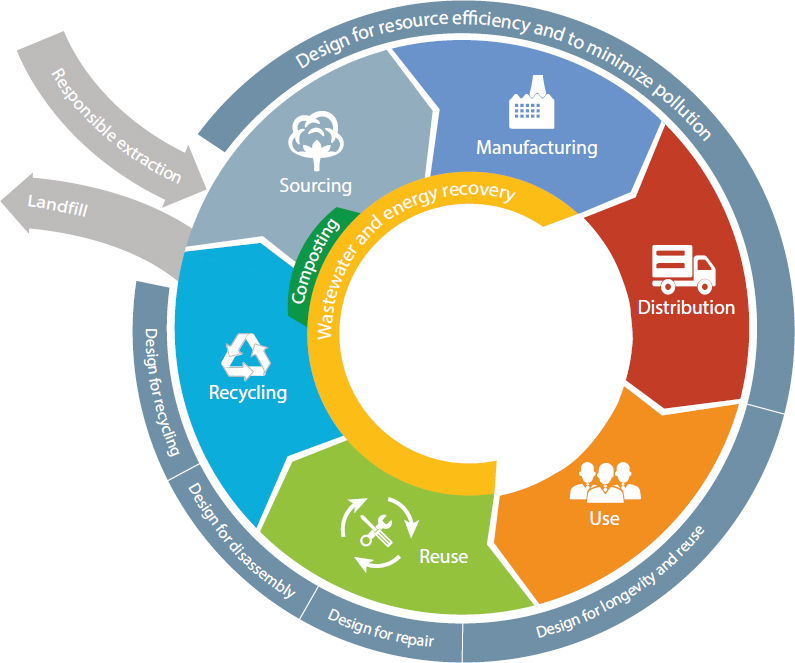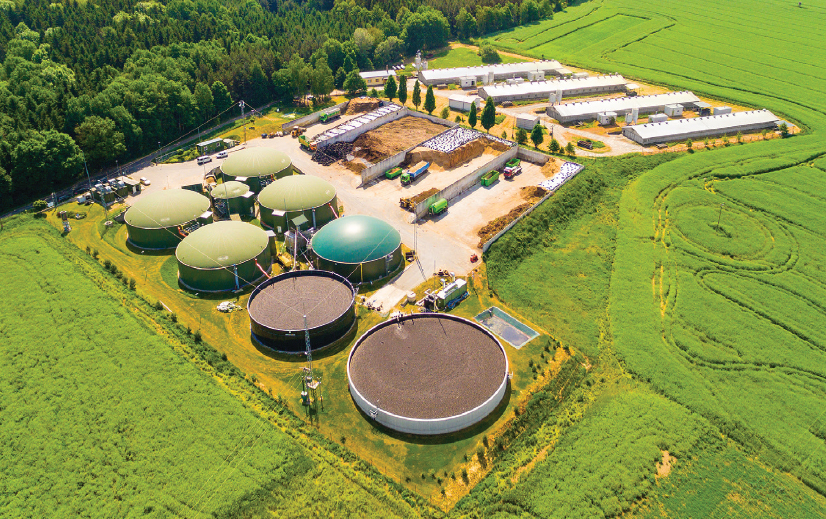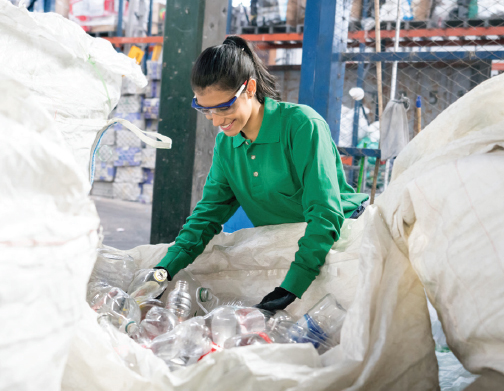
GRAND CHALLENGE 3:
Design a Future Without Pollution or Waste
In nature, waste is a resource. One organism’s waste is repurposed to sustain another. Since the Industrial Revolution, human society has adopted a more linear model. Resources and energy are used to manufacture products, which are then used and ultimately discarded as waste when those products are no longer wanted (Figure 3-1). This linear model of “take-make-dispose” has been successful in providing affordable products to billions of people and advancing their standard of living. However, this production model generates over a billion tons of discarded products and by-products globally each year (see Box 3-1), and uses large amounts of energy and resources that are never recaptured. An analysis of five high-income countries found that one-half to three-quarters of annual resource inputs are returned to the environment as waste within a year.159 Despite improved efficiency in the use of resources, the overall production of waste in many countries, including the United States, continues to increase.160
The “take-make-dispose” model introduces large amounts of pollutants into the water, soil, and air. Throughout much of the 20th century, large-scale chemical production combined with inappropriate chemical handling and waste disposal created a daunting array of legacy hazardous waste sites globally.165 Technologies to characterize these sites and contain and remove hazardous contaminants have advanced significantly over the past three decades, and there have been many successes.166 However, there remain at least 126,000 hazardous waste sites with residual contamination in the United States alone, about 12,000 of which are considered unlikely to be remediated to the point of unrestricted use with current technology. Some of these sites will require monitoring, treatment, and oversight in perpetuity.167 Meanwhile, new concerns associated with legacy contaminants continue to be discovered (Box 3-2).

Over the past few decades, the amount of pollution produced by some industries and activities has dropped precipitously thanks to research and technology advances and effective policy interventions (see Challenge 5). For example, regulations on heavy-duty diesel fuel emissions, the development of ultra-low-sulfur diesel fuel, and new emission control technologies have helped reduce particulate matter and nitrogen oxide emissions by more than 90 percent in diesel truck and bus engines put into use since 2010 in the United States.168 Nevertheless, large quantities of untreated sewage, industrial by-products, and vehicle emissions continue to find their way into the water, soil, and air.169 Human activities are causing nitrogen and phosphorus to accumulate in bodies of water170 and greenhouse gases to accumulate in the atmosphere (see Challenge 2).171 Toxic chemicals have been detected in people and wildlife in every corner of the globe, from the Arctic wilderness to remote tropical islands.172
Because of improvements in living conditions, including water treatment, sanitation, and health care, the 20th century saw a doubling of life spans globally,173 but pollution continues to have profound effects on human health. Pollution contributes

to the leading causes of death worldwide including heart disease, stroke, and chronic lung disease. One of every six deaths in 2015—about 9 million deaths worldwide—can be attributed to disease from exposure to pollution (Figure 3-2).174 Air pollution causes two-thirds of the premature pollution-related deaths, while unsafe drinking water and sanitation account for nearly 20 percent.175 More than 90 percent of the world’s population lives in areas where air quality does not meet health standards.176 Although the problems are worse in low- and middle-income countries where the sources of air pollution are minimally controlled, air pollution is estimated to cause nearly 400,000 premature deaths annually in high-income countries.177 Because these estimates do not account for compounds whose effects are not well characterized, for example, chemicals thought to cause endocrine disruption, the true toll of the health effects of chemicals is likely underestimated.
Pollution also harms natural ecosystems. Metals leaching into streams from abandoned mines have been linked with reduced biodiversity, and trace organic chemicals, such as pharmaceuticals, have been associated with reproductive anomalies including the feminization of male fish.178 Millions of tons of plastic end up in the oceans every year,179 creating large floating islands of garbage, and small plastic particles (“microplastics”) are accumulating in the food chain with a largely unknown effect.180 Wastewater discharges, urban and agricultural runoff, and fossil fuel combustion sources have overloaded lakes, estuaries, and rivers with nutrients, fostering algal blooms that can deplete oxygen and produce toxins.181 All of these ecological problems ultimately harm human health and disrupt industries such as fisheries and agriculture. In 2014, for example, about 500,000 residents of Toledo, Ohio, were ordered not to use their tap water for days due to toxins produced by an algal bloom in Lake Erie.182
Challenges posed by pollution and waste will intensify as the world’s population grows, people live in ever higher densities, standards of living increase, and industrial production expands to meet increasing demands. Two new approaches will be required to achieve economic progress while minimizing negative health and environmental impacts and sustainably managing Earth’s resources. First, a new paradigm of waste management and pollution prevention is needed—one that shifts from a linear model of resource extraction, production, use, disposal, and cleanup toward one designed to prevent waste and pollution from the outset. Second, innovative approaches are needed to recover valuable resources from the waste we do produce. Ideally the two approaches are closely coupled. These new approaches will require life-cycle and systems thinking to identify sustainable solutions that minimize the amount of energy and resources consumed and the amount of waste and pollution generated through all components of production and use.
Preventing Pollution and Waste Through Improved Design
Every day, new chemicals and materials are manufactured, elements are mined from the earth, fuels are burned, and fertilizers and pesticides are made and used. These activities are undertaken to support functions and provide services—such as the production of food, medicines, clothing, building materials, and electronics—that are vital to our society and economy. The question is now how to provide these functions and services without generating the types and scale of pollution and waste that have harmed human health and ecosystems in the past.
The solution requires working toward a circular economy designed to prevent harmful waste and pollution from the outset. Within a circular economy, processes are designed to minimize waste, products and waste materials are reused if possible, and materials that cannot be reused are remanufactured or recycled (Figure 3-3). Organic wastes that cannot be reused are converted to other useful products such as chemicals, materials, or fuels. Pollution prevention is also considered at every design stage to minimize negative impacts. Using materials


and chemicals that are relatively benign in the environment reduces risks to human and ecosystem health as they are cycled through the economy and society. When considering the entire life cycle, designs that reduce energy use and promote efficiency are emphasized. By thinking beyond incremental improvements (such as treating effluents on site) and working to develop innovative new approaches that eliminate waste and pollution, environmental engineers can help achieve a sustainable future.
Design is the stage that most influences the types and amounts of waste or pollution that will be generated. At the design stage, engineers are able to help select and evaluate the characteristics of the final outcomes, considering material, chemical, and energy inputs; effectiveness and efficiency; aesthetics and form; and specifications such as quality, safety, and performance. In the development of new systems, this stage is ideal for innovation and creativity and represents a key opportunity to integrate environmental goals into the specifications of the products or processes. Through life-cycle and systems thinking—as well as green chemistry and green engineering, which emphasize designs that ensure that inputs, outputs, and processes are as inherently nonhazardous as possible—new designs can be implemented that rely on more benign materials and less energy, that do not generate much waste, and that do not shift environmental burdens from one place to another. Benefits of such an integrated approach include wise use of resources, improved human health, and enhanced protection of natural systems. Advances needed to support a circular economy include efficient and effective separation and recycling technologies and market forces or government incentives that recognize the broader impacts of pollution and waste (see Challenge 5).
Many of the most successful interventions focus on preventing the production or release of pollution or waste. This strategy is generally easier and less expensive than remediating contamination sites after toxins are dispersed in the environment. For example, perchloroethylene, a widely used solvent for dry cleaning fabrics and metal degreasing operations and a likely carcinogen,192 has been replaced in these applications with supercritical carbon dioxide, which has low toxicity and is chemically stable, readily available, and easily recyclable. Another example is the recent movement away from subtractive manufacturing, a process by which three--

dimensional objects are constructed by successively cutting material away from a solid block of material. Instead, additive manufacturing, for example, 3-D printing constructs objects by successively depositing material in layers without the need to generate waste by cutting material away. A growing number of zero-waste businesses and communities aim to reuse, recycle, or recover at least 90 percent of discarded material while also aiming to produce no pollutants to air, water, or land.193
Eliminating the use of the most toxic chemicals is an important part of green design. To develop nonpolluting components and processes and prevent future contamination, it will be important to fill knowledge gaps about the full environmental risks of new and existing contaminants. For example, methyl-tertbutyl ether (MTBE) was added to gasoline to help reduce emissions in vehicle exhaust. However, MTBE became a groundwater quality problem once gasoline leaked from underground storage tanks because MTBE was able to migrate farther and was more resistant to biodegradation than other compounds in gasoline.194 Of the more than 140,000 new chemicals that have been introduced since 1950, fewer than half have been subject to human safety or toxicity testing.195 EPA’s Pollution Prevention Framework can be used to estimate physical properties, which are then used to predict environmental concerns such as toxicity, mobility, persistence, and bioaccumulation, but more development and validation is needed. In addition, there are significant needs related to risk communication to help the public and decision makers understand the true costs of pollution.
Capturing the Value of Waste
Under a linear production model, resources are used inefficiently and can become depleted as landfills expand. Recovering resources from waste recaptures the value of those materials and minimizes environmental impacts from further resource extraction. Localized or distributed recovery and reuse also reduces the energy requirements and pollution associated with transportation of materials and waste. Resource recovery can also address local resource shortages in economically depressed or geographically isolated communities.
Today’s common waste recovery efforts focus on recycling plastic, glass, paper, aluminum, and scrap metals, but much more is possible with advances in engineered environmental processes that allow the extraction of specific components from waste mixtures. Precious and rare-earth metals could be retrieved from electronic waste196 and potentially even mined from landfills. Carbon capture systems could be used to turn carbon dioxide into forms that are useful for applications ranging from building materials to plastics to greener solvents.197 Nutrients in wastewater could be captured for use as fertilizers (see Box 3-3).
Many of today’s municipal and agricultural waste streams are rich in organic carbon, which could be recovered and channeled toward chemical manufacturing or energy recovery.198 The amount of energy contained in wastewater is equivalent to several multiples of the amount of energy required to treat it.199 Energy recovery has been implemented at numerous centralized wastewater treatment plants, including in Oakland, California, and in Strass, Austria, by converting a fraction of the incoming organic carbon to biogas to produce heat and electricity.200 However, technologies have not yet been developed to cost-effectively capture the full potential of the embedded energy.201
Recovery of resources from waste streams has long been practiced, but in a nonsystematic fashion. In Dharavi, India, one of the largest slums in the world, people have built a thriving economy, employing approximately 250,000 people, based on recovering waste generated in Mumbai. “Gobar gas,” produced from anaerobic digestion of animal waste, is used for cooking and community-scale lighting in rural and urban communities, particularly in Southeast Asia and sub-Saharan Africa. Fly ash and gypsum by-products of coal combustion have been used in the manufacturing of concrete and wallboard.207

Resource recovery is rapidly being integrated into existing manufacturing, agricultural, and industrial practices, but much work remains to be done to realize its potential, both in terms of recovery yields and the types of resources that can be cost-effectively recovered. A significant impediment to utilization of waste is that existing traditional waste streams have not been systematically characterized with resource recovery in mind. Local, regional, and global inventories of waste materials are needed to identify opportunities for reuse or inputs to other production schemes. With this information, appropriate technologies for resource recovery can then be developed using physical, chemical, and biological processes that capture the maximum financial, social, and environmental benefits. This information could also lead industries to redesign their resource extraction and manufacturing processes to reduce waste and more efficiently and cost-effectively recover and reuse valuable resources.
Results of public programs to reduce, reuse, and recycle have been mixed. The United States, for instance, recycles or composts 35 percent of its municipal waste and less than 10 percent of its plastics,208 but higher rates are possible. Six countries recycle or compost more than half of their waste, led by Germany at 65 percent and South Korea at 59 percent.209 In 2016, nearly 48 million metric tons of electronic waste were produced globally, representing a value of approximately $60 billion in raw materials, and only 20 percent of this waste was recycled.210 EPA reports that electronic waste accounts for 70 percent of heavy metals in landfills, such as mercury, lead, and cadmium.211 Waste streams are often heterogeneous, complex mixtures that currently require significant resources and energy to separate. Sorting technology has been developed and commercialized for some wastes, such as separating organic from inorganic wastes. The extent of resource recovery from wastes could be enhanced by improved, cost-effective waste separation techniques.212
Effective waste recovery requires attention not only to scientific and engineering capabilities but also to economic and behavioral factors. Considerations of financial viability and feasibility include the cost of the recovery technology, the quality of the recovered product, the market for the product, any adverse environmental impacts, and measures required to manage and prevent them. Governments can also develop incentives to encourage waste recovery that account for broad societal and environmental benefits of these programs (see Challenge 5).
Many of these advances are focused on large urban areas, where the highest volumes of waste are generated. However, there is also substantial potential to harvest the value of waste streams that are smaller or more intermittent to benefit rural communities. For example, decentralized resource recovery systems could be developed, particularly for sewage, food, animal, and agricultural waste.
What Environmental Engineers Can Do
With training in environmental chemistry, microbiology, hydrology, transport processes, solid waste management, water and wastewater treatment, and air pollution—as well as skills in life-cycle and systems thinking—environmental engineers bring important capabilities toward designing a future without pollution
and waste (see Box 3-4). Technological advances combined with innovative new materials and designs can be used to conserve natural resources and minimize adverse effects on human health and the environment. These complex challenges demand solutions that consider broad costs and benefits throughout the life cycle, including human health risks, environmental impacts to water, soil, and air, as well as social and financial impacts (see Challenge 5). Environmental engineers can help analyze the impacts of innovative manufacturing and resource recovery approaches compared to the life-cycle impacts of traditional processes to identify the most promising solutions.
For many pollutants, although the knowledge and technology exist to reduce exposure, the greater challenges are economic, political, and social. For example, billions of people worldwide use solid fuel–burning cookstoves for daily meal preparation, creating large amounts of particulate matter pollution. It is possible to design cookstoves that are much cleaner burning to benefit health, local environmental quality, and climate, but there are cultural, economic, and logistical hurdles to their adoption.213 Improving resource recovery in developed countries may require people to change their behaviors and accept new approaches to waste separation. An interdisciplinary approach applying social and cultural knowledge is crucial to overcoming such hurdles to guide the development and adoption of sustainable solutions.










